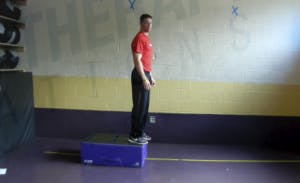Prior to utilizing jump training/testing, the physical therapist (PT) must understand the difference between vertical and horizontal jump performance following ACLR.
Initiated at the appropriate time, jump training/testing should be included throughout rehabilitation following ACL reconstruction (ACLR) or ACL injury to allow physical therapists to monitor and document the changes in physical competency throughout the rehabilitation process.
In addition to performance training, jump heights and jump distances are significant outcome measures to include in limb symmetry index thresholds for return to play (RTP) determination.
Horizontal Jump Drills
There are several horizontal jump drills recommended for RTP testing following an ACLR or ACL injury. The most commonly used horizontal jump test is the single leg hop for distance. Since the single leg hop distance is quick, convenient, and simple to measure, it is often included in testing protocols.



Cons:
The single leg hop test does not take into account the patient’s biomechanical deficits and compensation strategies. Recent systematic literature reviews conclude that ongoing deficits in biomechanical performance remain even after acceptable levels of symmetry are achieved during the single leg hop test. This is attributed to patients employing hip and ankle strategies to maximize jump performance and overcome deficits within the quadriceps.
Note that the horizontal distance patients achieve is determined by over 80% of the work being performed by the hip and ankle. During the subsequent landing, the knee contributes to around 65% to the landing strategy, supporting that landing is more demanding on any residual knee deficits than the propulsion phase.

Pros:
The single leg hop for distance is a good drill to challenge and analyze knee function during the landing phase. The amount of knee contribution during horizontal vs vertical hops explains why performance deficits are more apparent during horizontal hops in patients with knee impairments., For that reason, single leg hops should be an important part of both training and testing after a knee injury.
In addition to physical the biomechanical factors, the single leg test is beneficial to psychological readiness for return to play. By practicing single leg hop drills, the patient becomes more confident and develops improved competency of the knee joint. The more confidence a patient has in the stability of the knee, the less apprehension and hesitation the patient will experience with RTP.
Vertical Jump Drills




The most commonly used vertical test is the drop jump which is used to assess plyometric abilities. In the clinical setting, jump height is a more sensitive metric than hop distance to evaluate an athlete’s status during rehabilitation and at the time to return to sport after ACLR. Drop jump testing demonstrates consistent performance and biomechanical deficits at return to play and may more appropriately determine those at risk of a recurrent ACL injury.
Most horizontal jump tests reported after ACLR are single leg drills. With vertical jumps, both double and single leg tests are commonly utilized, providing additional information and allowing different strategies for the therapist to assess. While the hip and ankle commonly compensate for the knee deficits in single leg performance, the healthy limb assumes a greater amount of responsibility during double leg jumps.
Conclusion
Restoration of horizontal jump symmetry typically precedes that of drop jump symmetry due to the specific demands on the quadriceps between the propulsion phase of the tests. When assessing biomechanics, PT’s should evaluate both horizontal and vertical jump performance in all planes when evaluating rehabilitation status and/or making return to play decisions following ACLR or ACL injuries.
- Kotsifaki A, Korakakis V, Whiteley R, et al. Measuring only hop distance during single leg hop testing is insufficient to detect deficits in knee function after ACL reconstruction: a systematic review and meta-analysis. Br J Sports Med 2020;54(3):139-53.
- Kotsifaki A, Whiteley R, Van Rossom S, et al. Single leg hop for distance symmetry masks lower limb biomechanics: time to discuss hop distance as decision criterion for return to sport after ACL reconstruction? Br J Sports Med 2022;56(5):249-56.
- Kotsifaki A, Van Rossom S, Whiteley R, et al. Single leg vertical jump performance identifies knee function deficits at return to sport after ACL reconstruction in male athletes. Br J Sports Med 2022
- Kotsifaki A, Korakakis V, Graham-Smith P, et al. Vertical and Horizontal Hop Performance: Contributions of the Hip, Knee, and Ankle. Sports health 2021;13(2):128-35.

